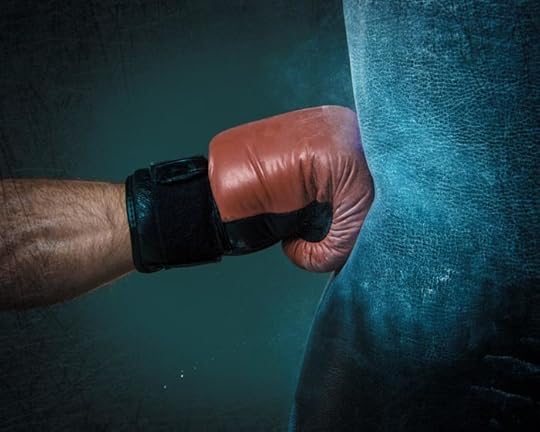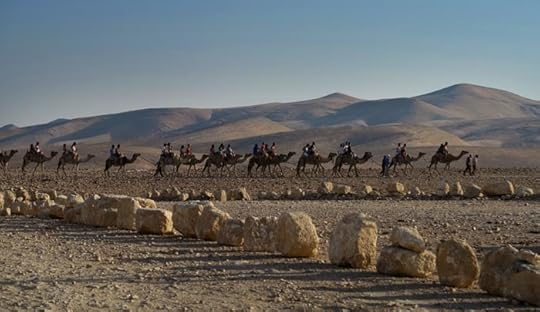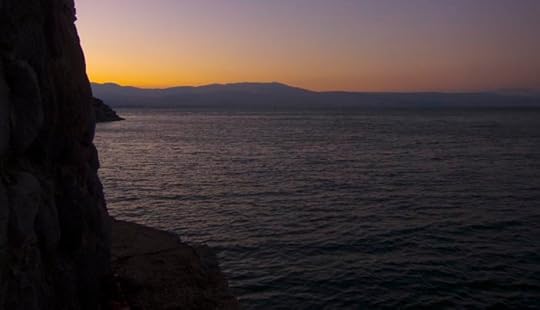In Search of Punch for the Page

“Full contact,” the instructor says. My gloves and pads are on, my opponent is a black belt, and the wall is lined with watching students – his friends, not mine. I’m the only foreigner here, and as I look around, that knowledge hits me with renewed force. I suddenly wish I hadn’t trained quite so hard this morning. I’ve been sweating around ten litres a day for two weeks – strength training in the morning, technique in afternoons, and a solid dose of cardio in the evenings. Every muscle is begging for a holiday. An ironic observer in my brain is sitting back, laughing at me. He glances out at my opponent who bounces around with obvious energy. “You’re going to die,” the observer informs me, while strapping on a seatbelt. I’m ready to collapse and sleep for two days, but I paste a confident smile on my face. “More than half of this is psychological,” I say to myself. Ironic observer snorts and gets his popcorn ready.
The thing about any kind of sequential technique is that it has to be so well rehearsed it can be recalled and acted on reflexively. There’s no time in the moment for, “Um, oh, yes – if you hold the knife that way then I need to use this hand and turn this way … no, wait, that way, and avoid, um … ouch!” I wonder if I’m going to be able to execute any of the numerous sequences I’ve been rehearsing.
Conversations subside till all we can hear is the whirring fans. Anyone who has played contact sports will know the rush of mindless adrenaline that takes place as teams surge towards each other. The thrill in a fight is more intense because you know your opponent has more comprehensive plans for you than just trying to stop or get past you. Of course, you have plans of your own for him, or you should have. The unfortunate reality is that the adrenaline keeps welling up and obscuring them. You have the rough idea memorized, though – win.
The fight starts. We avoid the dirty side of things like bending fingers and poking eyes (great for real self-defence), but we fight hard. By the fourth round, my internal observer is having to dive between steam jets from exploding valves and ricocheting rivets that shoot from bulging panels. I take a well-placed hook to the temple that spins my head guard around, covering my eyes. I don’t see the kick. I’m fairly certain it came from a horse. I once took a short flight courtesy of a large, feisty steed, so I make the comparison with some authority. The kick empties my lungs and almost empties my entire abdominal cavity. I half collapse, half dive at where I think my opponent is, and mercifully land on top of him, straightening my head guard as I do so. I just manage to hold in the vomit. Maybe I shouldn’t have – I’m pretty sure it would have won me the round. Spectacularly. Our instructor calls time which is probably a good thing – for both.
In spite of the exhaustion and bruises, I’ve seldom enjoyed myself so much. Very little gets the blood to race through vessels like heavy sparring. But this wasn’t about enjoyment as much as learning, and the amount I learned over the preceding two weeks is as much as I’d hoped for.
I started Krav Maga a few years back, so the style isn’t new to me, but what was new was the intensity of course and the experience of completing it in a profoundly foreign context. This was the main reason for the trip. It was important for me, while writing book 2 of The Wakening, to be reminded what it’s like to be a foreigner. Even when you are prepared for obvious differences – language, rules of the road, food, dress code, climate, and landscape – experiencing those differences, especially when you’re alone, brings a kind of disorientation that can’t really be understood by theory alone. It changes the way everything feels, from fighting to grocery shopping.
Being immersed in these details gave me several ideas about how a foreign setting would influence not just the actions, but also the state of mind of characters in the story. It has given me much to work with in the next rewrite of book 2, as well as in the rest of the series.
After the course, it was time to see the country, so for a week I travelled. This was the first time I’ve let someone else plan my itinerary, but it was the best decision I could have made. My PR manager researched and planned the week-long tour to perfection. Having that weight off my mind gave me the freedom to just let the environments soak into my thoughts.
Whenever I travel, I’m searching for stories. It’s not just a writer thing – I’ve been doing it all my life. Places inspire, but history does so even more, especially when you’re standing on the ground where the events took place. History, after all, is life, and it is life that inspires stories. Here are a few of the sights that have sent the story-manufacturing cogs whirring.
Perhaps I should just mention here that, when writing fantasy, I never base characters or regions directly on real people or places, because it just spoils that otherworldy experience. Aedan won’t at some point swim across a body of water so salty that it buoys him up like a float, burns his skin, and prevents anything surviving beneath it’s surface – a body of water known as the … er … Killed Sea. What I try to do when writing fantasy is harvest interesting experiences, look at the details that make them so, and use what I’ve learned to create new places and experiences within stories. Sometimes writers can stretch their worlds far past the one we know, but there needs to be some measure of relatability or there is no resonance, so discovering inspiration in the real world is important. Maybe it’s like any craft – you study what exists in order to know how to make something that doesn’t yet.
Bedouin camp in the Judean Desert

As you can see by the postures of the two men leading the group, this wasn’t camel racing, so an adrenaline rush it was not. But the spectacular openness of the desert, the oven-baked gusts of wind, and the complete unfamiliarity of almost everything I could see and touch made this Bedouin experience rich with inspiration. The camp itself is fairly commercialized, but the setting is nothing short of breathtaking in its rawness.
Masada

The best time to climb to Masada is before sunrise, partly to avoid the morning blaze, and partly because of the atmosphere that pre-dawn imparts to the ruins. The tragic history of this desert stronghold is as moving as the setting. Walking through the ancient buildings gives one a sense of privilege, and a poignant reminder of our mortality.
Safed
One of the most arty towns I’ve seen. There are galleries galore, musicians walking the streets, and charming restaurants with exceptionally toothsome food. In my opinion, the best places to stay here are the many small rooms attached to artist’s studios. I was at the neatest little spot owned by Shani and Sheva Chaya. It was literally five strides from an art gallery and a small glass-blower’s workshop where I had a fascinating demonstration of the craft.
Nimrod’s Castle in the Golan Heights

There is so much history in a castle. So much of the nature of humanity is expressed in those battlements forever watching the hills.
Can you see them? The band of attackers drifting down through the trees? Even now I can – I think. But if I raise the alarm and it turns out to be just my imagination … I wonder how many times these thoughts or similar ones churned behind arrow slits like this one.
Lake Tiberius (Sea of Galilee)

No, I was not swimming out into the lake at sunset. That would be irresponsible. The lake gets deep quickly and the currents are a little stronger than would be expected … apparently. This is a spectacular place. Sitting here on this sun-warmed ledge, I let the experiences of the past three weeks slosh and slap around like the water against the rocks below. Reading, researching and dreaming are good inspirations, but nothing competes with the texture of real life experience. These three weeks were well spent. I have much to take home with me, to invest into the pages of coming books.
The post In Search of Punch for the Page appeared first on Jonathan Renshaw.



